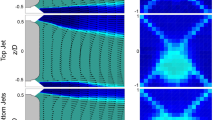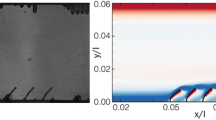Abstract
This article describes an experimental study aimed at stabilizing the wake of a shedding bluff-body by means of closed-loop active flow control at low Reynolds numbers. A D-shaped (6.5 mm thick) cylinder was used to allow a direct wake interaction rather than mixed wake-boundary-layer separation control. The fluidic actuators, installed inside the thin body, were ideally located at the separation locations, i.e., the trailing edges’ upper and lower corners. The wake unsteadiness was monitored by a pair of hot wires (HWs), while a single surface-mounted hot-film (HF) sensor was used as a frequency and phase reference for closed-loop control. The HF signal was contaminated by noise. Hence, a technique for real-time tracking of a low signal-to-noise ratio (SNR) signal was necessary. This was achieved by means of a Phase-Locked Loop (PLL), common in communications systems. The closed-loop scheme was based on real-time measurement of the wake-state, using the surface-mounted HF sensor, and control authority imposed by the fluidic actuators. By using opposition control at frequencies close to the natural vortex shedding frequency (VSF), it was possible to significantly reduce the wake unsteadiness. Applying the same approach, but sensing the wake HW signal, rather than the surface-mounted HF signal, as the controller input did not result in wake stabilization. On the contrary, the unsteadiness increased at all the tested conditions. It is expected that a similar approach would work at much higher Reynolds numbers as well, as long as a clearly identifiable and nominally 2D vortex shedding occurs, even when the background flow is fully turbulent.
Similar content being viewed by others
References
Adrian, R.J.: On the role of conditional averages in turbulence theory. In: Proceedings of the Fourth Biennial Symposium, Rolla, MO, September 22–24, 1975 (A77-40426 18-34), pp. 323–332. Science Press, Princeton, NJ (1977)
Allan, B.G., Juang, J.N., Raney, D.L., Seifert, A., Pack, L.G., Brown, D.E.: Closed loop separation control using oscillatory flow excitation. In ICASE Report 2000-32 (2000)
Blevins R.: Flow-Induced Vibrations. 2nd edn. Van Nostrand Reinhold, New York (1990)
Cattafesta L., Song Q., Williams D., Rowley C., Alvi F.: Active control of flow-induced cavity resonance. Prog. Aerospace Sci. 44, 479–502 (2008)
De Bellescize H.: La reception synchrone. Onde Electr. 11, 230–240 (1932)
Gerrard J.H.: The mechanism of the formation region of vortices behind bluff bodies. J. Fluid Mech. 25, 401–413 (1966)
Gharib M.: Response of the cavity shear layer oscillations to external forcing. AIAA J. 25(1), 43–47 (1987)
Gillies E.A.: Low-dimensional Control of the Circular Cylinder Wake. J. Fluid Mech. 371, 157–178 (1998)
Henning L., Pastoor, M., King R., Noack, B.R.: Feedback control applied to bluff body wake. In: Active Flow Control Conference, Berlin, Germany (2006)
Holmes P., Lumley J., Berkooz G.: Turbulence, Coherent Structures, Dynamical Systems and Symmetry. Cambridge University press, Cambridge, UK (1998)
Klapper J., Frankle J.T.: Phase-Locked and Frequency-Feedback Systems; Principles and Techniques. Academic Press, New York (1972)
Lehmann, O., Luchtenburg, M., Noack, B.R., King, R., Morzynski, M., Tadmor, G.: Wake stabilization using POD Galerkin models with interpolated modes. In: European Control Conference ECC (2005)
Moes, T.R., Sarma, G.R., Mangalm, S.M.: Flight Demonstration of Shock Location Sensor Using Constant Voltage Hot-Film Anemometry. NASA Technical Memorandum 4806 (1997)
Naim, A., Greenblatt, D., Seifert, A., Wygnanski, I.: Active Control of a Circular Cylinder Flow at Transitional Reynolds Numbers (part of AIAA Paper 2002-3070), Special Issue of Flow, Turbulence and Combustion on “Air-jet actuators and their use for flow control”, vol. 78, pp. 383–407 (2007)
Pastoor, M., King, R., Noack, B.R., Dillmann, A., Tadmor, G.: Model-based coherent-structure control of turbulent shear flows using low-dimensional vortex models. AIAA Paper 2003-4261 (2003)
Rapoport D., Fono I., Cohen K., Seifert A.: Closed-loop vectoring control of a turbulent jet using periodic excitation. J. Propuls. Power 19(4), 646–654 (2003)
Roshko, A.: On the drag and shedding frequency of two-dimensional bluff bodies. NACA TM 3169 (1954)
Roussopoulos K., Monkewitz P.A.: Nonlinear modeling of vortex shedding control in cylinder wakes. Physica D 97, 264–273 (1996)
Samimy, M., Debias, M., Caraballo, E., Ozbay, H., Efe, M., Yuan, X., Debonis, J., Myatt, J.: Development of closed loop flow control for cavity flows. AIAA Paper 2003-4258 (2003)
Seigel, S., Cohen, K., McLaughlin, T.: Experimental variable gain feedback control of a cylinder wake. AIAA Paper 2004-2611 (2004)
Stalnov, O., Palei, V., Fono, I., Cohen, K., Seifert, A.: Experimental validation of sensor placement for control of a D-shaped cylinder wake. AIAA Paper 2005-5260 (2005)
Stalnov O., Palei V., Fono I., Cohen K., Seifert A.: Experimental estimation of a D-shape cylinder wake using body-mounted sensors. Exp. Fluids 45, 531–542 (2007)
Tadmor, G., Noack, B.R.: Dynamic estimation for reduced Galerkin Models of fluid flows. In: The 2004 APC Meeting, pp. 746–751 (2004)
Tadmor, G., Noack, B.R., Morzynski, M., Siegel, S.: Low-dimensional models for feedback flow control. Part II. Observer and controller design. AIAA Paper 2004-2409 (2004)
von Kàrmàn, Th.: Über den Mechanismus des Widerstands, den ein bewegter Körper ineiner Flüssigkeit erfährt. Nachr. Wiss. Ges. Göttingen. Math. Phys. Kl., pp. 509–517 (1911)
Williamson C.H.K.: Vortex dynamics in the cylinder wake. Annu. Rev. Fluid Mech. 28, 477–539 (1996)
Yehoshua T., Seifert A.: Boundary condition effects on the evolution of a train of vortex pairs in still air. Aeronaut. J. 110(1109), 397–417 (2006)
Author information
Authors and Affiliations
Corresponding author
Additional information
Communicated by T. Colonius
An erratum to this article can be found at http://dx.doi.org/10.1007/s00162-010-0209-3
Rights and permissions
About this article
Cite this article
Stalnov, O., Fono, I. & Seifert, A. Closed-loop bluff-body wake stabilization via fluidic excitation. Theor. Comput. Fluid Dyn. 25, 209–219 (2011). https://doi.org/10.1007/s00162-010-0197-3
Received:
Accepted:
Published:
Issue Date:
DOI: https://doi.org/10.1007/s00162-010-0197-3




